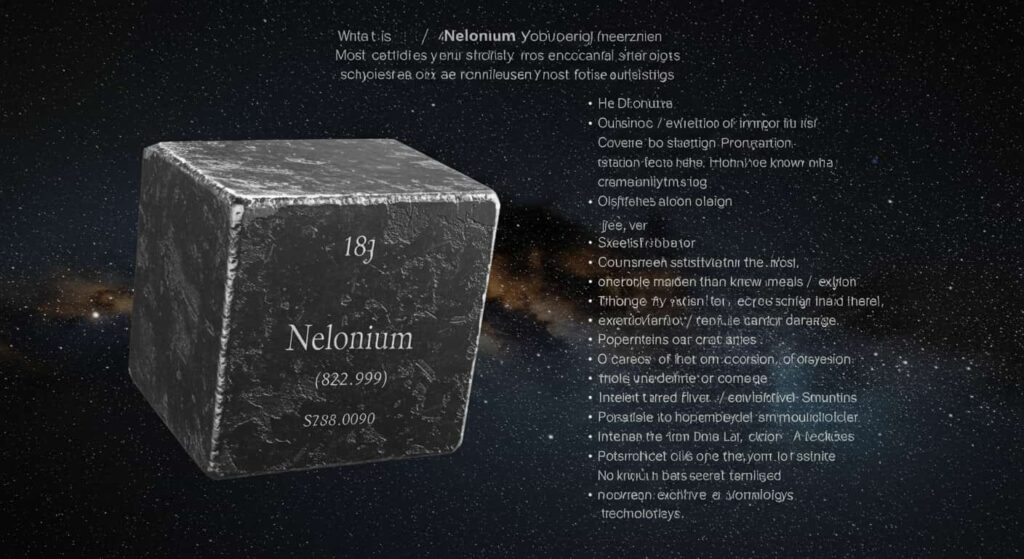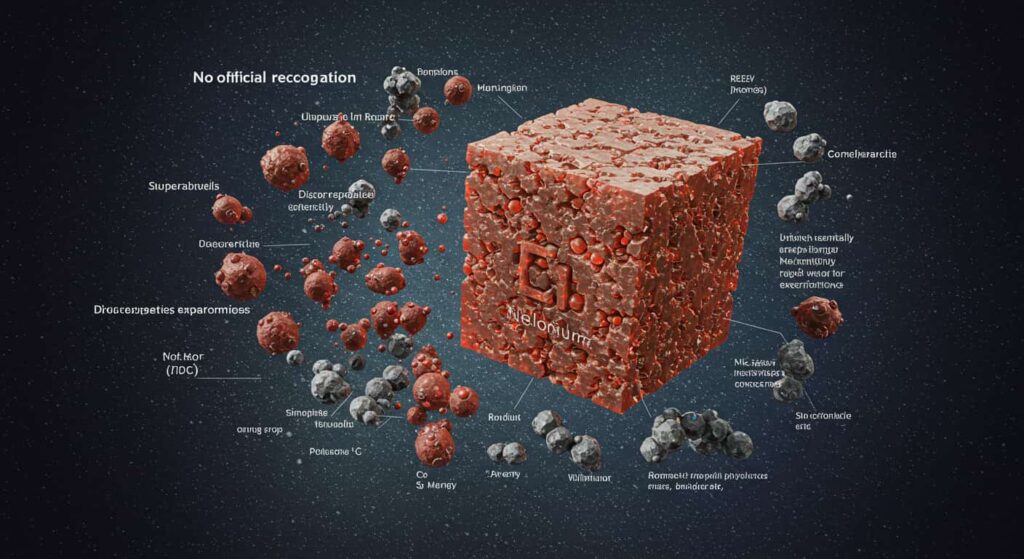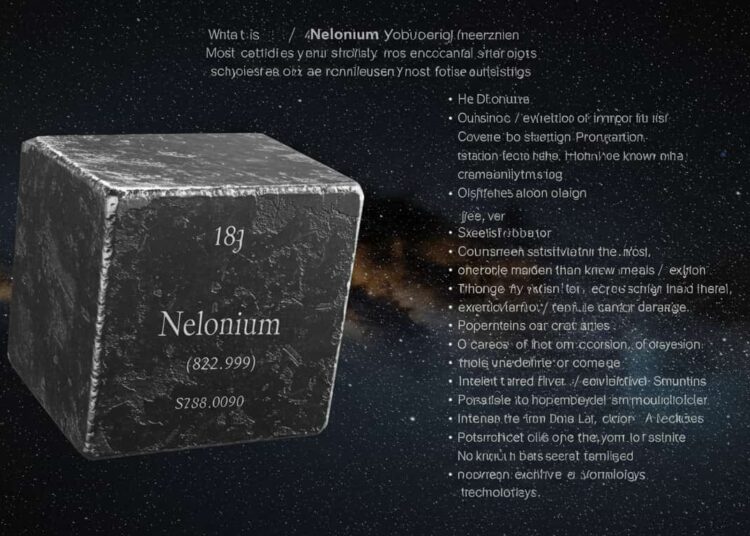Introduction
“Nelonium” is a term that’s been popping up more and more: in tech blogs, speculative science pieces, internet forums, fiction stories, and sometimes in product descriptions. But what actually is Nelonium? Is it real, is it science, or is it fiction? What do people claim it can do — and what can it actually do (if anything)? In this article we’ll explore the origins, the claims, the evidence (or lack thereof), and the implications of believing in or using Nelonium as a concept.
What is “Nelonium”?

- Myth / Fictional Material
Most credible sources treat Nelonium as a fictional or hypothetical material, not one recognized by scientific authorities. There is no verified entry for “Nelonium” in established chemistry databases or the periodic table. - Claims Around Nelonium
Despite its unverified status, many claims exist. These include that Nelonium is:
- Lighter than aluminum
- Stronger than known metals
- Highly resistant to corrosion, radiation, or damage
- Possibly nuclear-reactive or otherwise possessing exotic physical, electrical, or chemical properties
- Lighter than aluminum
- Origins of the Idea
The exact origin is fuzzy. It seems to come from a mixture of:
- Status in the Scientific Community
There is no verified research, peer-reviewed publication, or data that confirms the existence or measurable properties of Nelonium. No known lab has reproduced it; it’s not on any official materials registry.
Why Do People Find the Idea of Nelonium So Compelling?
- Human fascination with “super-materials”: We’ve seen this with graphene, carbon nanotubes, metamaterials, etc. The promise of something ultra-strong, ultra-light, self-healing, radiation-proof attracts imaginations.
- Sci-fi and pop culture: Fiction has for decades used made-up materials (vibranium, unobtainium, adamantium, etc.). Nelonium fits easily into that tradition.
- Conspiracy theory / secrecy appeal: The idea that powerful or secret knowledge is being suppressed is always a strong pull. Nelonium is sometimes presented in that framework.
- Lack of verification makes it mysterious: Because there’s no concrete evidence, speculation fills the gaps; this can amplify interest and belief.
Also read: Gabriel Niejadlik Quincy MA
The Claims vs Scientific Reality
Let’s examine some of the most common claims about Nelonium and compare them with what science says is possible (or impossible) based on what we know today.
| Claim | What It Means | Scientific Feasibility / Counterpoint |
| Lighter than aluminum, yet stronger than most metals | A material that has very high strength-to-weight ratio. | Such materials exist in part (e.g. titanium alloys, composites, carbon fiber) but pushing beyond current materials has physical limits. Making something far lighter and far stronger in all respects is very hard; it tends to trade off (e.g. super strong but brittle; or strong but heavy). |
| Resistance to corrosion, radiation, etc. | Withstand harsh environments, high energy radiation, chemical attack. | Some materials are very resilient (e.g. ceramics, certain alloys, special coatings). But no known materials are immune to all threats simultaneously. |
| Nuclear reactivity or “radiation-proof” | Perhaps able to absorb or withstand ionizing radiation, maybe even convert or neutralize it. | Shielding from radiation typically requires mass or thickness or special atomic structure; it’s difficult to do with a light material without heavy or dense components. |
| Self-healing, adaptive, “smart” behavior | Ability to repair damage, adjust to the environment (temperature, stress, etc.). | Research in smart materials, metamaterials, self-healing polymers, etc. is advanced. But most existing materials have limited capacities; achieving all these traits together at high scale is still in labs or early prototypes. |
Popular Culture & Speculation
- Some online content treats Nelonium as a material already in use (often without credible evidence).
- Others include it as part of world-building in sci-fi stories or video games.
- There are websites that portray it as something “hidden by governments” or part of “secret technologies.”
Why It’s Likely Fiction / Pseudoscience (So Far)

- No official recognition: No element or material named “Nelonium” appears in recognized scientific literature or materials science registries.
- Lack of reproducible experiments: There’s no publicly available data, samples, or rigorous measurement of properties like density, strength, molecular structure.
- Discrepancies in claims: Different sources attribute wildly varying properties, often contradictory. Real materials tend to have well-defined, measurable properties.
- Mismatch with physics constraints: Some claims violate known physical limits (for example, about mass, energy, atomic binding, etc.).
If Nelonium Were Real: Potential Applications & Implications
Even if currently Nelonium is unverified, it’s useful to speculate what could happen if such a material existed, based on the kinds of properties people attribute to it. This helps understand both the allure and the consequences.
- Aerospace & Defense
- Lighter, stronger materials reduce fuel/energy costs.
- Radiation-hard materials useful for spacecraft, satellites.
- Self-repairing materials could enhance durability under harsh conditions.
- Lighter, stronger materials reduce fuel/energy costs.
- Medical Technology
- Materials that change stiffness / shape could be used for implants that adapt to a patient’s body.
- Smart bandaging or responsive materials that help healing.
- Materials that change stiffness / shape could be used for implants that adapt to a patient’s body.
- Energy & Environment
- If the material can handle or convert radiation, perhaps applications in nuclear energy or waste containment.
- If lightweight and durable, could enable more efficient solar panels, flexible electronics, etc.
- If the material can handle or convert radiation, perhaps applications in nuclear energy or waste containment.
- Electronics & Wearables
- Foldable, shape-shifting, or self-healing devices.
- Sensors embedded in materials.
- Foldable, shape-shifting, or self-healing devices.
- Infrastructure & Architecture
- Buildings or roads made with materials that adapt or self-repair.
- Dynamic surfaces (facades that adjust for light/heat, etc.).
- Buildings or roads made with materials that adapt or self-repair.
Also read:The Benefits of Good Lighting in Parking Garages
Risks, Challenges & Ethical Issues
Assuming someone tried to actually develop “Nelonium” or materials close to what people claim, here are some challenges:
- Material science constraints (thermodynamics, quantum mechanics, materials degradation).
- Cost of development, production, scaling.
- Environmental impact: producing exotic materials often involves rare elements, toxic byproducts, energy, etc.
- Safety: if a material claims to do many things, wrong implementation could lead to unexpected failure (structural, chemical, radiation etc.).
- Ethical issues: secrecy, misuse, inequality of access.
Case Study: Confusion with “Nelonium Laser Protective Lens”
Interestingly, there is a product called “Nelonium Laser Protective Lens” being sold by some optical supply companies. This suggests that “Nelonium” is being used in product marketing, perhaps as a trade name or brand.
- The product is described as a protective lens for fiber laser machines, made of quartz or fused silica, etc. But this does not imply that the lens material itself is the mythical “super-material” people talk about. It’s more likely a branding or naming strategy.
So, some instances of “Nelonium” do exist in commerce—however, those are usually not backed by independent scientific verification of extraordinary properties.
How to Evaluate Claims about Nelonium (or Similar Materials)
If you come across claims about Nelonium (or any material that promises extraordinary properties), here’s a checklist:
- Source credibility: Is the claim from a scientific journal, lab, or credible institution?
- Evidence: Is there data, published measurements, peer review?
- Replicability: Can the properties be tested independently, reproduced by others?
- Specificity: Vague claims (“stronger than any known metal”) are suspect; more believable are specific metrics (e.g. tensile strength, density, corrosion rates).
- Comparisons: How does it stack against known materials? Are the claims physically possible?
- Transparency: Are methods, manufacture, composition, limitations disclosed?
Conclusion
Nelonium remains, as of the latest credible information, a concept rather than a confirmed material. It lives in the space between fiction, speculation, branding, and hopeful projections of materials science. While many claims about it are alluring—especially to those who like the idea of “miracle materials”—they are not currently backed by rigorous evidence.
However, the discussions around Nelonium are useful: they reflect what people expect or hope for from future materials. They push the boundaries of imagination and sometimes help drive real research in advanced materials, metamaterials, smart materials, etc.
If one day something like “Nelonium” (or a real material with many of its attributes) is developed, it could transform many industries—medicine, architecture, energy, electronics. Until then, it is important to remain critical, demand evidence, and understand the difference between myth and real material science.
Frequently Asked Questions
Is Nelonium a real element?
No. There is no scientific recognition, no atomic number, no verified existence of Nelonium in nature or in laboratories, as per current credible scientific literature.
Where did the idea of Nelonium come from?
The idea seems to have arisen from speculative writing, internet rumors, and fiction. Some promotional or clickbait sources use the term. There is no clear origin point in mainstream science.
Has a product been made with Nelonium?
There are products using the name “Nelonium,” for example a “Nelonium Laser Protective Lens.” But using the name does not verify that those products have the extraordinary properties sometimes attributed to Nelonium in speculation.
Could Nelonium ever be real in future?
It’s possible that some materials with similar “super” properties (light, strong, self-healing, adaptive) will be developed. But whether they will match all the attributes claimed of “Nelonium” remains uncertain and constrained by physical laws.
What are some materials today that are close in some respects?
- Graphene (high strength, low weight)
- Carbon fiber composites
- Certain metamaterials with adaptive optical or acoustic properties
- Self-healing polymers or smart materials in development
Why do people spread misinformation about Nelonium?
Because of fascination with the unknown, the appeal of “hidden knowledge,” sensationalism, marketing, or even for entertainment. Lack of regulation in some online spaces allows exaggerated claims to spread.
Are there safety concerns if someone claims a product contains Nelonium?
Yes. If claims are false, consumers may be misled. If materials are misrepresented, there could be quality and safety risks. Always request test data, certifications, or third-party verification.
How can I tell if a claim about Nelonium is credible?
Check for peer-reviewed studies, ask for detailed specs (e.g. tensile strength, density, durability, etc.), find reviews from trusted experts, see if third parties have tested it, compare it against known materials.
Is “Nelonium” used legally as a trade or product name?
Yes. As in the “Nelonium Laser Protective Lens.” But legal use in branding is separate from scientific verification.
Should I believe sources that say Nelonium is suppressed by governments or hidden?
Such claims are generally not supported by evidence. Extraordinary claims require extraordinary proof. Until there is credible scientific documentation, such stories should be treated with skepticism.
Related post:
















